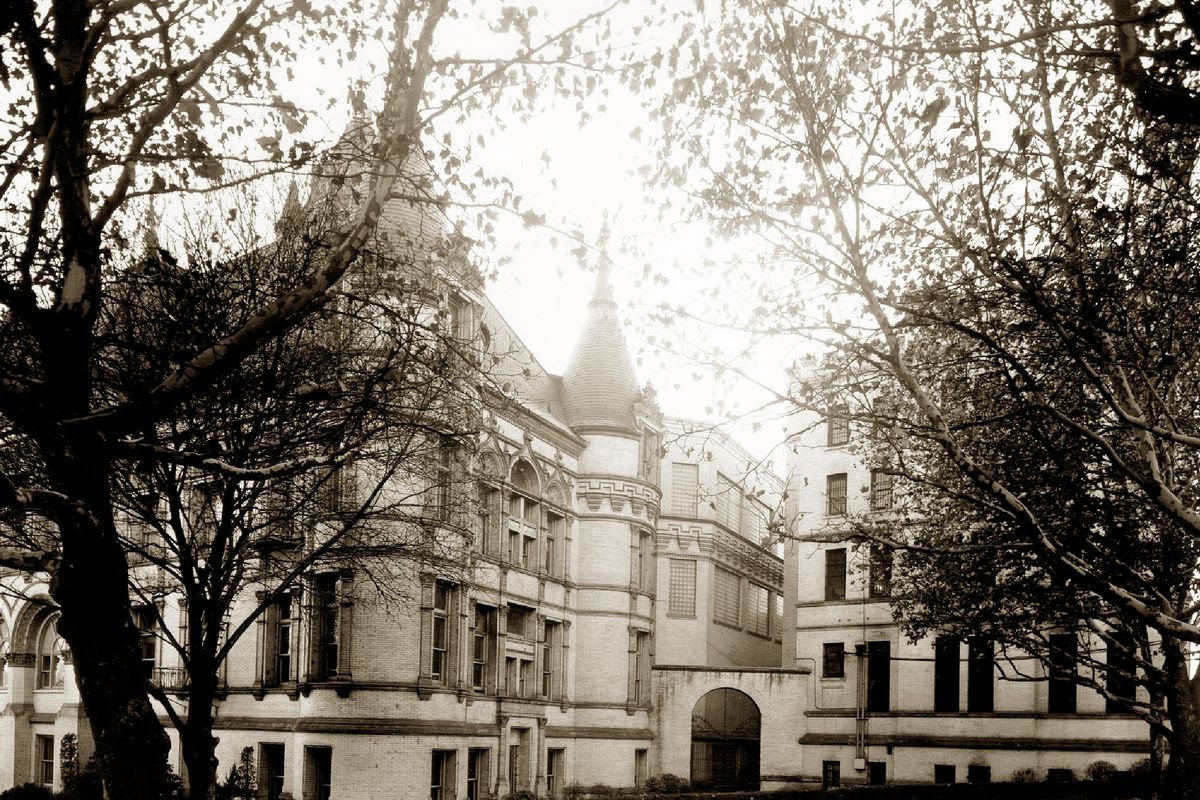Landmarks: Restored gates dedicated at Spokane County Courthouse

Sometimes a chance meeting leads to a happy discovery and the eventual restoration of a thought-to-be-lost artifact, something that turns out to be a significant piece of Spokane’s history.
That was the case one day in 2008 when Don Secor, who was Spokane Parks Department superintendent at the time, and Chuck King, a history buff involved with the Spokane Valley Heritage Museum, bumped into each other at a yard sale.
They got to talking, and Secor told King about some old rusting iron gates he had seen leaning up against a fence out at Plante’s Ferry Park in Spokane Valley. He was pretty sure these were the gates that had once stood under a brick archway connecting the Spokane County Courthouse to the old county jail.
The jail and gates had been torn down in 1970 to clear the way for construction of a new Public Safety Building. The removed gates were first stored in the courthouse’s maintenance shop, but no one seems to know how they found their way to Plante’s Ferry Park, where they seemed destined to be forgotten and lost to history.
It wasn’t hard to verify that the gates were the originals, designed in 1895 by Willis A. Ritchie, Spokane County Courthouse architect. But to be absolutely sure, there were also archival photos to compare with. Plus Ritchie, who was known for his meticulous and exacting detail, had created very explicit drawings of the 11-foot-tall wrought iron gates, down to even the hinges that would be used on them.
King and Secor contacted Sue Wallace, secretary-treasurer of the Spokane Law Enforcement Museum, and she brought in Ron Oscarson, courthouse facilities manager – all of whom were eager to bring back these pieces of history to the courthouse – and so, the Spokane County Courthouse Iron Gates Restoration Project was begun. And, of course, a major component included raising money to fund it.
The rediscovered gates were donated to the Law Enforcement Museum. Grants were secured, donations were given, assorted permissions were granted and labor was donated or provided mostly at cost. Nearly $30,000 has been raised through a variety of means, big and small, including Nostalgia Magazine donating 125 copies of the book it published, “The Nat: Memories of Natatorium Park,” and selling them at the Spokane County Fair in 2015, with $2,500 in proceeds going to the project. However, another $20,000 is needed to finish paying for everything, Walker said.
A decision had to be made about powder-coating the gates, which would have made them look like new again, but in the end, it was felt best to leave the original patina, according to Rick Nelson of Ornamental Gate and Fence, the local company in charge of cleaning and power washing the gates.
The gates themselves were quite striking – true works of art, according to Wallace – when first installed more than 120 years ago. It was through these ornamental gates, weighing 550 pounds each, that arrestees were brought into a courtyard and to the jail for processing, and it was in the courtyard – estimated by Oscarson to have been 100-by-70 in size – between the two buildings where they were let outside to get some fresh air and exercise.
Family members of the prisoners could also come and look through the gates to see their loved ones in the courtyard, Oscarson said.
For a time, they were known as the “Gallows Gates” after two prisoners were hanged in the courtyard, one in 1897 and another in 1900. About 150 invited guests attended the public hangings inside the courtyard, but one historic account states that some 1,000 people gathered outside the gates to witness the spectacle as well. (It should be noted that another man was hanged in the area in 1892, before the courthouse and gates were erected).
“The gallows’ connection to the gates is really a misnomer,” said Oscarson, who retired earlier this year, “None of us who worked on this project like the reference or find it accurate. In fact, the two men who were hanged came into the courtyard from the jail, not through the gates.”
It had been hoped that the gates could be put in the same location where they once stood, but location of the Public Safety Building plus stairs and a wheelchair ramp have created an elevation difference that makes it impossible, Oscarson said.
“While you can still see the imprint on the brick of the Courthouse where the original archway stood,” he added, “we’ve been able to install the gates in a newly-constructed freestanding archway near the original location. We hope the public will come to see them and read the historic plaque that explains their history.”
“I am so pleased that there are people who cared enough about history, our history, to take the time to preserve and bring these gates back to us,” said Vicky Dalton, Spokane County auditor, a self-described big fan of the project. “They stepped up and did the work, and we are all the richer for it.”